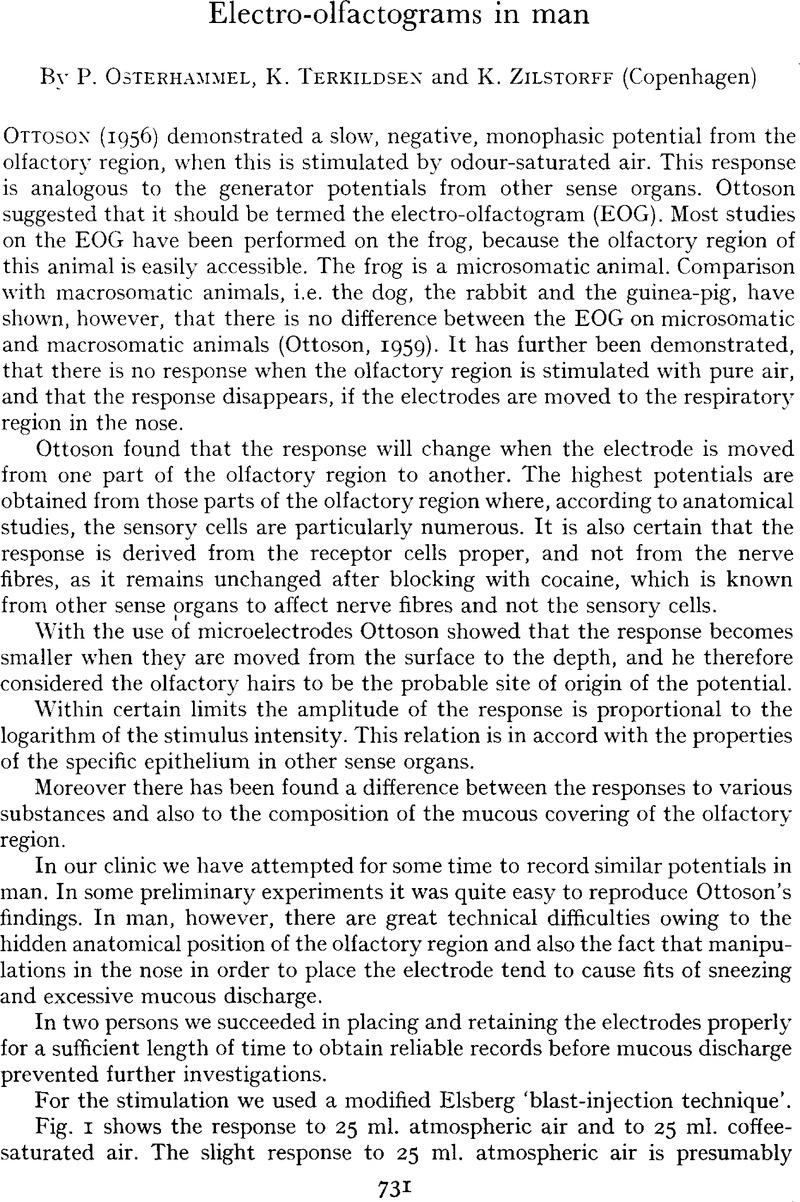Crossref Citations
This article has been cited by the following publications. This list is generated based on data provided by Crossref.
Ottoson, David
1971.
Olfaction.
Vol. 4 / 1,
Issue. ,
p.
95.
Vainio-mattila, Juhani
1974.
Correlations of Nasal Symptoms and Signs in Random Sampling Study.
Acta Oto-Laryngologica,
Vol. 77,
Issue. sup318,
p.
1.
Herberhold, C.
1975.
Funktionspr�fungen und St�rungen des Geruchssinnes.
Archives of Oto-Rhino-Laryngology,
Vol. 210,
Issue. 1,
p.
67.
LANCE, JAMES W.
and
McLEOD, JAMES G.
1981.
A Physiological Approach to Clinical Neurology.
p.
219.
Kobal, Gerd
and
Hummel, Cornelia
1988.
Cerebral chemosensory evoked potentials elicited by chemical stimulation of the human olfactory and respiratory nasal mucosa.
Electroencephalography and Clinical Neurophysiology/Evoked Potentials Section,
Vol. 71,
Issue. 4,
p.
241.
Furukawa, Mitsuru
Kamide, Michihiro
Ohkado, Takao
and
Umeda, Ryozo
1989.
Electro-Olfactogram (EOG) in Olfactometry.
Auris Nasus Larynx,
Vol. 16,
Issue. 1,
p.
33.
Doty, Richard L.
Kreiss, Deborah S.
and
Frye, Richard E.
1990.
Human odor intensity perception: correlation with frog epithelial adenylate cyclase activity and transepithelial voltage response.
Brain Research,
Vol. 527,
Issue. 1,
p.
130.
Kobal, Gerd
and
Hummel, Thomas
1991.
The Human Sense of Smell.
p.
135.
Thu¨rauf, Norbert
Hummel, Thomas
Kettenmann, Birgit
and
Kobal, Gerd
1993.
Nociceptive and reflexive responses recorded from the human nasal mucosa.
Brain Research,
Vol. 629,
Issue. 2,
p.
293.
Kobal, Gerd
and
Hummel, Thomas
1994.
Olfactory (Chemosensory) Event-Related Potentials.
Toxicology and Industrial Health,
Vol. 10,
Issue. 4-5,
p.
587.
James Evans, W.
Cui, Liying
and
Starr, Arnold
1995.
Olfactory event-related potentials in normal human subjects: effects of age and gender.
Electroencephalography and Clinical Neurophysiology,
Vol. 95,
Issue. 4,
p.
293.
Rossiter, Karen J.
1996.
Structure−Odor Relationships.
Chemical Reviews,
Vol. 96,
Issue. 8,
p.
3201.
Hummel, T.
Knecht, M.
and
Kobal, G.
1996.
Peripherally obtained electrophysiological responses to olfactory stimulation in man: electro-olfactograms exhibit a smaller degree of desensitization compared with subjective intensity estimates.
Brain Research,
Vol. 717,
Issue. 1-2,
p.
160.
Kobal, Gerd
2003.
Handbook of Olfaction and Gustation.
Wang, Liwei
Hari, Churunal
Chen, Lixin
and
Jacob, Tim
2004.
A new non-invasive method for recording the electro-olfactogram using external electrodes.
Clinical Neurophysiology,
Vol. 115,
Issue. 7,
p.
1631.
KNECHT, M
and
HUMMEL, T
2004.
Recording of the human electro-olfactogram.
Physiology & Behavior,
Vol. 83,
Issue. 1,
p.
13.
Jacob, Tim J.C.
and
Wang, Liwei
2006.
A new method for measuring reaction times for odour detection at iso-intensity: Comparison between an unpleasant and pleasant odour.
Physiology & Behavior,
Vol. 87,
Issue. 3,
p.
500.
Hummel, Thomas
Mojet, Jos
and
Kobal, Gerd
2006.
Electro-olfactograms are present when odorous stimuli have not been perceived.
Neuroscience Letters,
Vol. 397,
Issue. 3,
p.
224.
Ottoson, David
2008.
Ciba Foundation Symposium - Taste and Smell in Vertebrates.
p.
343.
Lapid, Hadas
Seo, Han-Seok
Schuster, Benno
Schneidman, Elad
Roth, Yehudah
Harel, David
Sobel, Noam
and
Hummel, Thomas
2009.
Odorant Concentration Dependence in Electroolfactograms Recorded From the Human Olfactory Epithelium.
Journal of Neurophysiology,
Vol. 102,
Issue. 4,
p.
2121.



